#but they also kinda paved the way for improvement in the processes
Explore tagged Tumblr posts
Text
I was talking about Hiram and the Deviless and soullessness today, and the thing that makes it all so compelling to me is:
There is a void inside you that can never be filled. A part of you will always be missing no matter how much you don't care about it. But what if one day you actively chose to care about someone and that's what ultimately saves you.
What if the person you chose to care about the most was the one who took away your ability to care in the first place? What if you were already caring about them, and you had to choose to care again, knowing that you could never do it in the same manner as before? Would you even care this much if that old part of you was still in place? Was that feeling so different from the active choice you make day after day after day?
Much to think about.
#something something feelings vs actions#something something choosing to actively care every single day forever#the first part is very self indulgent bc I had to deal with anhedonia for years and the descriptions of soullessness in fl are just. yeah.#the second part is just my love for narrative themes and I love how both hiram and the deviless caused all their problems#but they also kinda paved the way for improvement in the processes#a weird convoluted way but they work so well together#anyway I am very normal about my characters 👍#(also I'm trying to get over the npc syndrome too and I like to talk about my blorbos)#hiram hargrave#hiram x deviless
11 notes
·
View notes
Text
Plans for nengi.js 2.0
Hi, this is Alex, the people’s network programmer and developer of nengi.js. Let’s talk about the future.
I consider nengi 1.x to be complete. Of course there are always unfinished items of work -- I wish I had a comprehensive tutorial series on prediction for example -- but really things have been stable and good for a long time.
So as I look towards 2.0, there are no fundamental changes to the library in mind. Instead the future is about improvement, making things easier, and staying open to deeper integrations with other libraries and possibly even with other languages.
One area of intended improvement is the whole process around forming connections both on the client and the server.
On the clientside, client.readNetwork() or equivalent is invoked every frame as the mechanism that pumps the network data into the application. However, this pump also controls the network data related to the connection -- meaning that without spinning the game loop one cannot finish trading the data back and forth that completes the handshake. I’d like to redo this such that we end up with a more normal api, e.g. client.connect(address, successCb, failCb) or equivalent. This presents a clean flow with no ambiguity as to when a connection is open. It’ll also let the clientside of games be a bit tidier as they don’t need to spin the network in anticipation of a connection opening.
On the serverside the whole .on(‘connect’, () =>{}) warrants a redo. I have in mind a simpler api where a ‘connectionAttempt’ occurs, and then the user code gets to invoke instance.acceptConnection(client, greeting) or instance.denyConnection(client, reason) thus again providing a nice and clean exact line after which we know what state the connection is in (attempted => connected, or attempted => denied).
Another area is Typescript support and some positive side-effects thereof. Nengi has minimal typescript definitions, but I think the actual surface of each api class/function should be rewritten in actual typescript. This will be limited, as the actual inner workings of nengi are truly untyped -- it has its own crazy typesystem and fancy optimization of high speed iteration based on object shapes that I should stop talking about now before I accidentally write a dissertation.
Per adding Typescript support there will be a major benefit to Typescript and JavaScript developers alike which is the opportunity for some top tier intellisense. The nengi api is small and having some modest documentation pop up right as you type things like .addEntity would be awesome.
The other benefit (ish..) of formally supporting Typescript is that a few of the processes around how to integrate game logic and nengi could finally be strictly addressed. I used to favor a very laissez-faire approach to integration as I didn’t want to stifle anyone’s style… but as time has gone by it seems that the level at which nengi can be decoupled is not seen as powerful, and instead it just confuses people. I want a better newbie experience, and presenting things like “well you can kinda do anything” isn’t helpful. I wouldn’t necessarily limit nengi itself, and instead may supply this functionality as a layer, but I would like to suggest a much stricter boilerplate for topics such as associating game data with a connected client and any other spot where game and network get glued together.
On that note of making things less open ended, I am *considering* whether nengi should offer an Entity and Message etc as part of the api. Currently entity is a concept or an implied interface -- really it is any object. Too decoupled? Maybe something more explicit would be nice. We’ll see.
More advanced protocols/schemas are also needed in the future. There are a bunch of features that can easily come from having more options on the protocols, but initially I plan to skip over all of these features and just change the api in a hopefully future-proof manner. The plan here is to change things from protocol = { x: Int, y: Int, name: String } to something more like context.defineSchema({ x: Int, y: Int, name: String }). Initially these will do the same thing, but in the future more arguments will be added to defineSchema.
The eventual removal of types from nengiConfig is another dream feature that may or may not make 2.0 but is worth a bit of discussion. NengiConfig.js is that file where every entity, message, command etc is listed out. Removing this would require nengi to be able to explain *in binary* how to *read future binary* and is non-trivial. The benefit however is that the parallel building of client and server code would no longer be a strict requirement. In the end of course a client and server need to be built for one another, but if the relationship were less strict than it is now it may pave the way for eventual nengi clients that aren’t even JavaScript. To me this has always been a bad joke -- who would want such a thing??? But as the years have passed it has become clear that nengi is not just special for being JavaScript, but that it is actually competitive in performance and functionality with the type of technology coming out of AAA multiplayer gaming companies (send money!!). So this may not be a bad direction (though it is worth noting there are at least two other major changes needed on this path).
There would also need to be changes to the current ‘semver’-ish release cycle. As it stands currently nengi version numbers follow the rules of breaking changes on major release (1.0.0) non-breaking changes on minor release(0.1.0) and small patches on patch release (0.0.1). As the current version of nengi is 1.18.0 that means that I’ve managed to add all functionality since release without a single breaking change (send money?!). This is not easy. These new changes described above are deliberately breaking api changes. Given the work cycle that I’m on and the lack of funding, the most efficient way for me to work would be with breaking changes allowed and perhaps a changelog to help the users out. So 2.0.0+ may shift to this type of development, where the ‘2’ is just my arbitrary name for the functionality, and 2.1.0 is a potentially breaking change. Obviously no one has to join me over in the land of nengi 2 until it becomes more stable, but letting me do *whatever* will get everything done faster, which is more important than ever given my limited time.
In the category of “maybe 2.0 things” here are a bunch of other things I’d like to talk about too, but they’re too involved (and experimental) of topics to go into detail. Here’s a vague summary of things I’ve put R&D time into:
Experimentally rewrites of sections of nengi in Rust, C, C++ with integrations via n-API, wasm transpilation, and some in-memory efforts. Crossing the boundary between JavaScript and anything else has been problematic as a means of solving most obvious problems, but some less-than-obvious problems may yet warrant this approach. I would say that n-API is a dead end for most nengi functionality but has some merit for spreading sockets across threads. WASM, or specifically working on a continuous block of memory may have some promise but requires further R&D.
An advanced rewrite of the nengi culler based on spatial chunking (promising!).
A middle api between serving up interpolated snapshots and the nengi client hooks api. This would become a generic replacement for the entire nengi clientside api. Until further typescript support I’m going to leave this one alone as it is very likely that a naturally elegant solution will show itself in the near future.
Multithreaded nengi, specifically the spreading of open connections across threads and the computation of snapshots. True optimal CPU use is opening multiple instances, not giving more threads to an instance, but there are some uses nonetheless.
Multi-area servers that use spatial queries instead of instances or channels (for example creating multiple zones, but not making an instance or channel per zone, instead the client.view just goes to a different space with some spatial math).
So yeah, that’s the plan! Thanks for your support (send money)
https://github.com/sponsors/timetocode
https://www.patreon.com/timetocode
2 notes
·
View notes
Text
My HP AU
My original post is here for context. I got some angry anon messages after I said that Fred didn’t die in my AU. It’s already a given that everyone’s MC is it’s own au anyway, so why not implement more changes anyway? It’s not like they’ll overwrite the main canon story (yet some people like anon act like they do). This is just the less cluttered version of my list of differences.
Cedric doesn’t die and is one of the people openly on Harry’s side when the Ministry is running the smear campaign against him and Dumbledore.
Everything comes from this post here. Please give it a read. It’s kinda long but I highly recommend it. I’ll shorten it here as best as possible. I’ve had this in the back of my mind for close to a year now and I’m glad I found it again.
Cassius Warrington was a Slytherin in the same year as Cedric, and he also put his name in the Goblet of Fire, but obviously wasn’t selected. In the linked post, as well as for this AU, he gets selected over Cedric.
Despite objections from the other Houses, the guy legitimately proves himself. He could’ve cheated and used every underhanded tactic possible, but didn’t. Ambition doesn’t have to be a bad thing. It can also be used for good.
Hogwarts has two champions, so why not prove themselves by working together? He’d start helping out Harry in the same manner Cedric would’ve, and in time the relations between Slytherin and Gryffindor would’ve started improving.
Warrington getting murdered at the graveyard would’ve been just as shocking, of course. He was still a student at the end of the day, and was disposed of so easily. Word gets around that Voldemort of all people gave the order to kill him, and Slytherins are terrified.
It’s no secret that most of their parents are Death Eaters, and for a fellow Slytherin like Warrington to have been deemed nothing more than a spare was something no one ever saw coming. It sent the message that Voldemort doesn’t care for those in his way, pureblood or not.
This leads to Slytherins joining Dumbledore’s Army (paving the way for their relations with the other three Houses improving greatly), some secretly going out of their way to help Harry with inside information of the workings from their Death Eater parents, and more than plenty of Slytherins joining the other three Houses in defending Hogwarts in the ensuing battle.
Slytherins should’ve been allowed to shine much earlier on. There’s more to them than just being one dimensional bullies. It wasn’t until the 6th book that we got one Slytherin that wasn’t some antagonistic fuck in the form of Prof. Slughorn.
So yeah, in exchange for Cedric living and Cassius dying in his place, it would’ve led to Hogwarts being truly united as it always should’ve been. I’m sure I’m not the only one that wasn’t a fan of how the Slytherins were handled in the final book, and how it was topped in the epilogue by “eh they’re aight now but their edgy past still lingers pffff”.
**********************
Sirius survives the Battle at the Department of Mysteries and the Battle of Hogwarts. With his name finally cleared following Pettigrew’s eventual death, after the Battle of Hogwarts he decides to travel the world for a time as a truly free man. There’s no doubt he’d like to see just how much the world truly changed during the 12 years he had been locked away.
Dumbledore still died at Snape’s hands like in canon, as I feel it’s a necessary death to help push the story forward. It’s a massive turning point in the Second Wizarding War, I believe.
Fred doesn’t die at the Battle of Hogwarts cuz I love him way too much and I’ve never gotten over it. The Weasleys deserve all the happiness, dammit.
Snape survives, but just barely.
He didn’t trust that fucking snake for a second and secretly took steps that made him immune to her venom.
In his near-death state, he encounters James and Lily in limbo. Amends are made, and the couple thanks Snape for watching out for Harry all those years. He’s then told to go back, as it’s not his time yet.
Once he makes a full recovery and his true allegiance to Dumbledore is made public, he takes time off to rediscover himself and process his second chance at life.
Tonks and Lupin survive as well, as they very damn well deserve to happily raise their son together. It’s Lupin’s heroism during the battle that helps turn the tides of how werewolves are treated for the better. All the discriminatory laws are abolished and they’re allowed to live life like everyone else, actually treated like people. Wolfsbane potions are made much more affordable and efforts to find a cure are highly supported.
Harry’s second son is named Arthur Rubeus instead of Albus Severus.
9 notes
·
View notes
Text
I have a lot of Revolver based rambles so, bear with me.
Revolver’s life has just been, fucked from the get-go huh?
He spends the first 8 years living with a single parent who is more than likely neglectful. Like he clearly wasn’t active in Ryoken’s life /during/ the Lost Incident and if he could easily just step out of his life for that then he probably wasn’t active in it to begin with. Plus Aso and Kyoko seem to have been fairly close with Ryoken when he was a kid.
Then Ryoken tries to do the right thing only to have his father take from him, left without him for a number of months (I can’t remember if it was specified how long SOL kept him for) only to be returned in a coma.
Then at some point between then and when Ryoken was 13 his father decided to recruit him into committing genocide(remember the first attack on the Cyberse World happened when Ryoken was 13, something they probably had to have been working on for a while before then).
So like, neglected all his life to suddenly have his dad go ‘hey why don’t you help me destroy the things I’ve created cause they’re a threat to humanity’ while he was still a kid no less.
Yeah, of course he sided with him, dad finally wanted his help, wanted to spend time with him, he probably jumped at the chance lbr.
But then that fails and they spend 5 years trying to find the Ignis and the Cyberse World (is it sad that this is probably the most time he’s spent with his dad? cause yeah it kinda is). And like, kid’s are impressionable, so getting these ideas into him as early as 13 means they’re gonna be hella hard to break later down the line when they’ve been ingrained into him for literal years.
He’s, basically been groomed for this. For literal years.
And then Playmaker shows up and WHOOP the Lost Incident is back to haunt him now as he realizes that he was one of the kids.
Then the Tower of Hanoi. Everyone loves to harp on how Ryokenr did that and was willing to sacrifice thousands to save millions(or millions to save billions) but ya’ll seem to forget, the Tower was Dr. Kogami’s idea. He was the one that planned it, that built it, that kick started it.
Ryoken simply followed him because why wouldn’t he? He wants to be a good, obedient son who follows daddy’s wishes (and has been doing so for at least 5 years at that point), he wants to make him proud (and after all if it ultimately saves even more people then it’s worth it right?) he wants him to pay attention to him and notice him cause goddamn he is starved for attention from his father. And the road to hell as they say, is paved with good intentions. ‘destroy these things to save the world’ is a noble goal. Just not when you go about it by also trying to bring out plenty of casualties in the process.
And then, his father dies, saving him. Even if his old man sucked he was still his dad, and Ryoken did everything for him, for his approval, so that he’d actually pay attention to him.
He’s having to break free from literal years worth of conditioning and grooming and you /can/ see him trying.
He’s going out of his way to avoid dragging innocent people into the fight with the Ignis, he’s trying to minimize who actually is involved. He’s gone from ‘kill all the Ignis’ to ‘kill this specific one cause it’s the problem’.
It’s baby steps, he’s not gonna get there right away, it takes time, people don’t change over night. And man I’d say this is some good improvement for 3 months. And I feel like his improvement has taken, bounds since teaming up with Team Playmaker. It takes time to unlearn old/bad habits and learn new ones, to change ways you’ve been set in for LITERAL YEARS. Especially when you’ve been to blinded by anger and hatred (and self loathing, cause you can bet no one hates Ryoken more than Ryoken hates himself) and don’t know anything else.
132 notes
·
View notes
Text
The Marketing Chronicles Behind 30% Annual Revenue Growth at Top E-commerce Software House
The Internet was opened to the public back in 1991, after the invention of the World Wide Web. This opened the Pandora box: online shopping! By 1999 global e-commerce reaches $150 billion.
But behind great e-commerce lays great e-commerce software.
Divante is aiming to be just that: great e-commerce software house, by providing top-notch e-commerce solutions and products for both B2B and B2C segments.
And with a revenue that increases annually by 30%, we think they’re kinda there, what do you think?
And take a look at that: a Deloitte Technology Fast 500 nomination in 2017, with a 4-year revenue growth of 259%.

So, what’s the recipe behind the growth?
Definitely the product should be top notch. But without the right sales and marketing strategies, a great product just ain’t enough.
So, in this blog post we’ll decipher Divante’s marketing strategies, from the inbound perspective, social media, but also we’ll sneak inside their team and employer branding
TABLE OF CONTENT
Divante E-commerce Software House - Short Overview
Divante’s Marketing Strategies Reverse Engineered
Brand Awareness at Divante
Divante’s Website and Conversion Rate Optimization
Divante’s Traffic Acquisition
Content Marketing
Divante’s Social Presence
Employer branding and hiring
Wrap Up
From banking, telekom, fashion, Divante knows it all. Just look at their clients.

Impressive, right?
But how? That is the question.
Let’s find out.
Divante E-commerce Software House- Short Overview
Some Divante facts: 10 years on the market, 100+ global clients, 150+ team members, 300+ projects delivered and 2 open-source solutions developed for e-commerce.

The feedback on Github, Capterra and g2crowd looks really good for Vue Storefront, which is acclaimed as No. 1 open source progressive web app for e-Commerce:

So, the future looks bright for Divante, from where we stand.
But, let’s see what the Divante clients have to say about them:
Deep knowledge, commitment and full support
Managed to increase traffic and income
Go the extra-mile
Delivery with tight deadlines
Expertise and professionalism
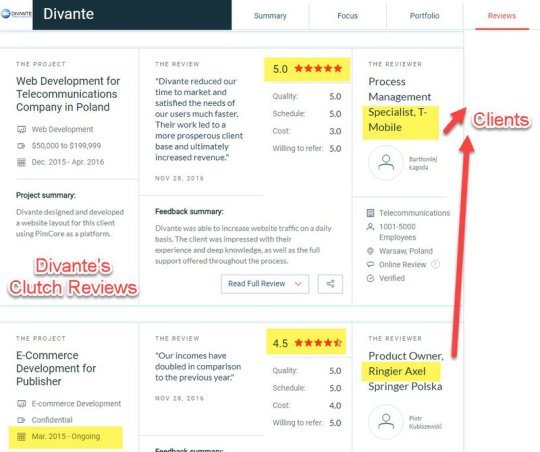
“Our income has doubled”, “reduced our time to market”, “increase website traffic” - that’s what I call results oriented.
But how did Divante get here: a top player in the e-commerce software industry?
Follow me to find out:
How developing open source products can pave your way to success
How the proper branding efforts can get you first-rate clients
How inbound marketing can portrait you as an expert in the field and build trust around you
Divante’s Marketing Strategies Reverse Engineered
After so much pain and struggle for a former communist country, it’s time for a rebirth.
Poland is reinventing itself and reshaping the IT outsourcing environment.
“When life gives you lemons, make lemonade” - this came to life in Wroclaw.
Divante, the e-commerce software house is leading the way.
T-Mobile, Ringier Axel, Continental, Tchibo, Intersport are just a few of Divante’s global clients.
But what lays behind the lemonade?
Strategic marketing.
And we’ll reverse engineer it.
Brand Awareness at Divante
A brand vision should attempt to go beyond functional benefits to consider organizational values; a higher purpose; brand personality; and emotional, social, and self-expressive benefits. ― David Aaker (the father of modern branding)
Every step a business makes, in relationship with each and every stakeholder, will translate itself in branding.
A satisfied customer, an unhappy employee, an empowered student at a hackathon, a comment on social media, everything will generate word-of-mouth and brand awareness.
So, what does the market have to say about Divante?
First of all, we’ve mentioned the Deloitte Technology Fast 500 nomination in 2017 and the Clutch reviews.
Further on, in our article, we’ll see how community and social media engagements are handled.
Because, in the end, with all the tech development, the human touch will get you fans, employees and customers.
Divante’s Website and Conversion Rate Optimization
The website has a intuitive and user friendly interface. It’s easy for the buyer persona to find an answer to its questions:
Who is Divante?
E-commerce software house
What solutions do you provide?
Progressive web apps, Pimcore Development, Magento development, integrations, user experience design and more.

The menu is well organized, with clearly stated submenus in terms of products and services.

How can I trust you?
Case studies backed by data, testimonials, client listing.



How can I contact you?
“Contact us” button
“Estimate a project” button in the homepage, above the fold
Contact form

In terms of conversion rate optimization, they seem to be using Hotjar (according to SimilarTech) and have just removed Crazy Egg from their technology stack.


They’ve also removed Visual Website Optimizer.
So they wanted to mingle with A/B testing and CRO, but, so far, on their website I haven’t noticed any personalizations.
Speaking of personalization, it seems that Divante uses Hubspot for marketing automation. I assume they want to improve their processes and be more customer-centric.

Divante’s Traffic Acquisition
The main website traffic sources are:

The 50%+ direct traffic is the highest we’ve analysed so far in IT Outsourcing. We find ourselves in a position of making some assumptions now.
What could account as direct website traffic?
offline events: conferences, meetups and hackathons
referral traffic not tagged
sales reps activities
A percentage this high is kinda jaw-dropping. And I believe that the brand awareness is impressive with this folks.
And the fact that branded traffic is pretty high, would probably back me up in my assumption.

Content Marketing
The blog is updated about bi-weekly. Lots of categories are used.

The posts are not very technical, and they’re mostly managed by Agata Młodawska, the Marketing Manager and Aleksandra Kwiecien, the Content Manager. From time to time, some pieces of content are signed by Tom and Piotr Karwatka, the CEO and CTO of Divante.
And even more rarely, a developer gets involved in content writing.

But let’s see which are the most valuable pages on the Divante website:

It seems that the most traffic is brought on the homepage by the brand name itself “divante”. Next in line we have blog posts, the case studies section and the products page.
But let’s take a look at the keywords.

It seems that there is no clear strategy around specific keywords, no keyword cluster manages to rank.

On the other hand, they have created really powerful long form pieces of content:
Guides
eBooks
Analysis reports
Case studies
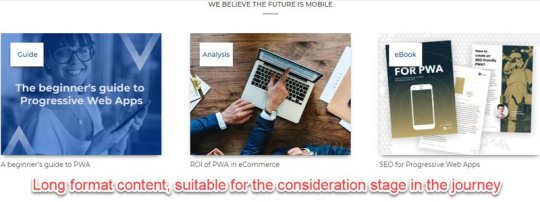
The case studies are not telling the whole story, so, if a potential customer wants to see the whole picture, Divante uses the power of lead magnets: a win-win exchange between the potential customer (who provides a contact detail) and Divante (who provides a downloadable case study).

Speaking of lead magnets, here’s another one:

Also, they’ve bundled together some of the reports, in a lead magnet:

For the users that want to move on further in the funnel, switching from consideration to decision making, Divante can offer demos.

So, be it awareness, consideration or decision, Divante has everything covered across the buyer’s journey.
Moving on, Divante also includes newsletters in the content strategy:
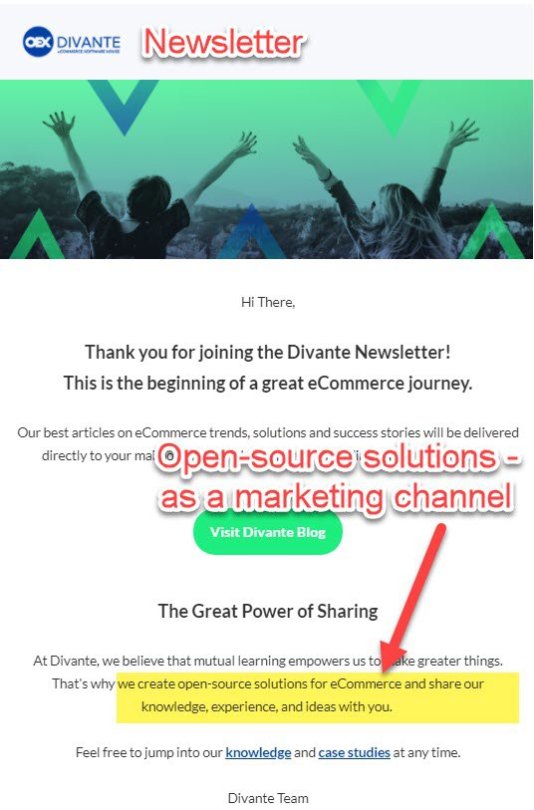
They’ve got content also on Slideshare, 81 presentations!
430+ followers and lots of views.

Backlinks to Support Content Marketing
Do-follow links from 70+ domain ranking websites link back mostly to the Divante homepage and blog.

The do-follow links come from e-commerce themed websites such as: ecommerce-europe.eu, pacticalecommerce.com, ecommercenews.eu.
Divante’s Paid Traffic Acquisition
In terms of paid Google search ads, Divante is promoting the Magento development service, bidding on “magento web development” related keywords.


The landing page is really compelling, with its clear CTA and above the fold social proof.

Spyfu estimates a budget around $2k.
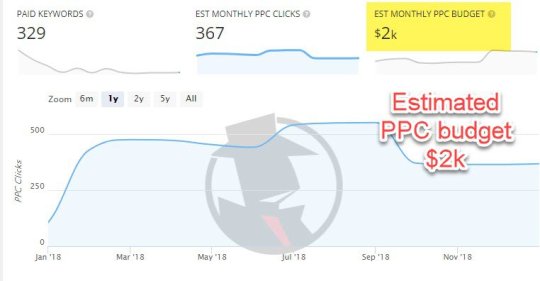
While the Google search ads are Magento focused, on the sponsored Facebook posts side we see a progressive web apps approach.
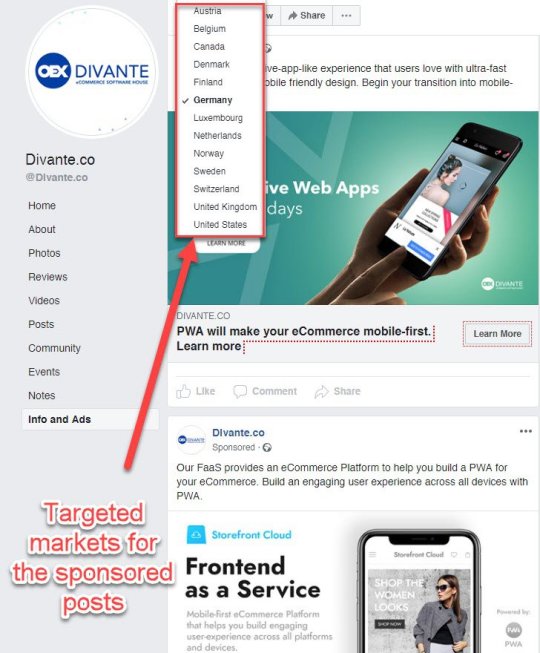
Social Selling
Regarding the Medium positioning, it seems that Piotr Krawatka, CTO of Divante, and other Divante colleagues are editing The Vue Storefront Journal.

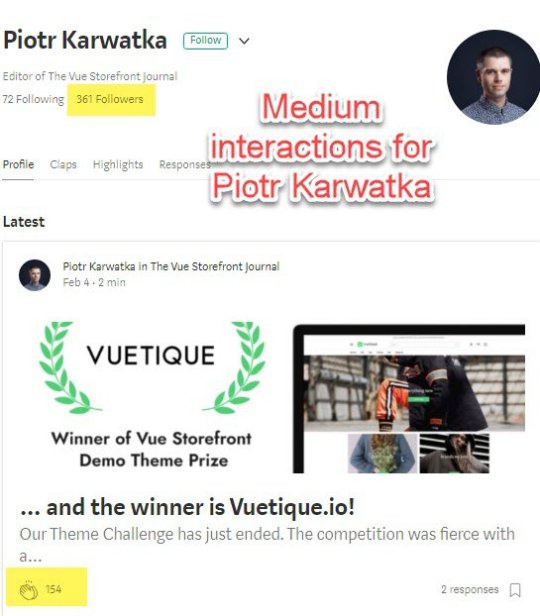
Beginning with June 2018, there is an increasing Medium focus. And the engagement seems rewarding.
Until now, I haven’t seen such an up to date Medium profile, among other Polish software houses.
Divante’s Social Presence
Social media is a great channel for a business to include the community in the communication, help build trust and develop long-lasting relationships.
Divante clearly understands this, just look at these numbers:
7500+ Facebook followers
1600+ Twitter followers
2300+ Linkedin followers
Divante’s Facebook Page
Divante’s Facebook profile has a client-approach. Through publishing posts consistently, Divante wants to prove expertise in the field, hence build trust around the brand.

The posts are merely about:
Promoting long form content - eBooks, guides, reports
Successful integrations of their Vue Storefront product or PWA
Events they organize or attend to
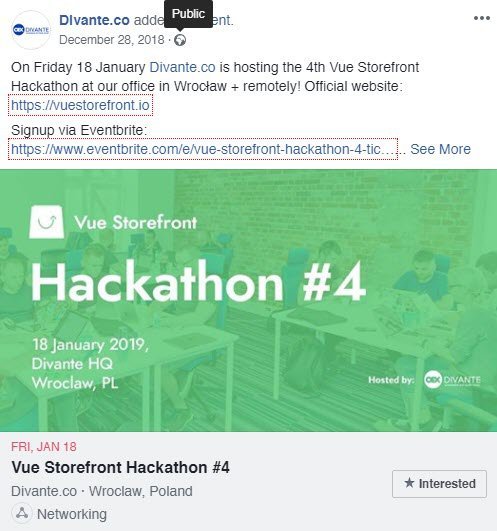
The interactions are a bit scarce.
But this isn’t a surprise. From what we’ve analyzed so far, the most popular posts for software houses posting on Facebook, are people related, such as team events, introducing team members etc.


LinkedIn
The LinkedIn profile content is also client-aimed. News from the industry, blog posts, eBooks are shared.

Hiring is also a LinkedIn objective, just like in the case of the other software houses we’ve analyzed so far.

Twitter
Divante almost replicates the Facebook and Linkedin content within its tweets.

Events are in the spotlight here: speaking gigs, attending conferences and summits.
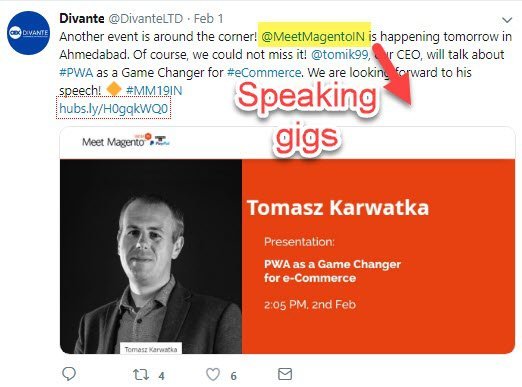
Curiously, this is the first software house I’ve encountered that does not rely much on social media to build employer branding.
The communication is mostly oriented towards gaining new clients.
Divante’s Community Involvement
Whenever you would see a Magento event, for sure Divante is there.
They don’t usually miss making an appearance, as attendees or speakers.

On the employer side, Divante hosts Magento related events, as you might have already guessed.
They ain’t at all shy: meetups, hackathons, they are really building their employer branding in the Polish community.

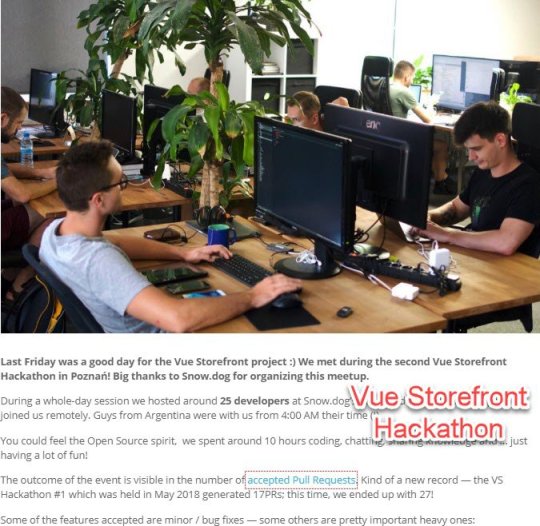
But these are just a drop in the ocean.
Take a look at the community built around Vue Storefront!

Employer branding and hiring
On single Glassdoor review for Divante, a positive one, but, statistically speaking, not significant.
As we’ve mentioned before, through community networking, Divante is opening communication doors with future employees.
Speaking of, they have 12 ongoing open positions, mostly for developers.
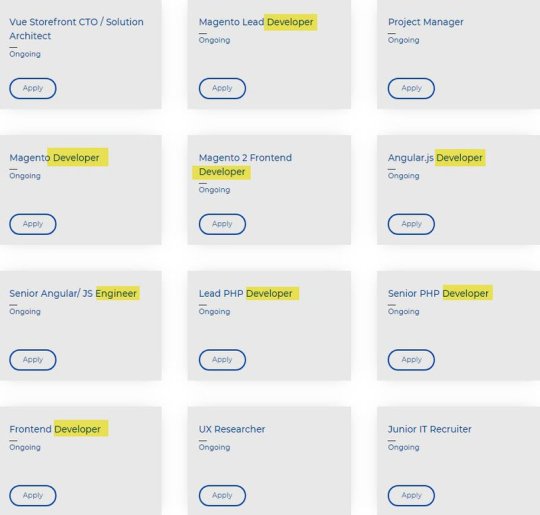
The “ongoing” status of the jobs explains a lot, especially when you look at this data: 650+ developers wanted in Wroclaw.

Wrap Up
From the B2B marketing point of view, it seems that a consistent content strategy, seasoned with some events and marketing automation, is the recipe of success for this e-commerce software house, Divante.
But let’s make a more comprehensive list of takeaways:
Release valuable open source projects
Go the extra mile in the relationship with your clients
Have a content strategy across the entire buyer’s journey
Letting your community in on your plans for the future is great for business, it builds trust and increases brand awareness
So, this was our Divante pit stop.
But the race ain’t over yet.
And it’s not only about Wroclaw, or Poland.
We’re looking at an entire IT outsourcing ecosystem, a flourishing ecosystem, built on the ashes of former communist countries.
So, check out our Ultimate Guide To IT Outsourcing Companies in Central Eastern Europe and to see below the tip of the iceberg.
if(window.strchfSettings === undefined) window.strchfSettings = {}; window.strchfSettings.stats = {url: "https://man-digital.storychief.io/ecommerce-software-house?id=171813012&type=12",title: "The Marketing Chronicles Behind 30% Annual Revenue Growth at Top E-commerce Software House",id: "4f08255c-5e51-436c-99aa-71482a308009"}; (function(d, s, id) { var js, sjs = d.getElementsByTagName(s)[0]; if (d.getElementById(id)) {window.strchf.update(); return;} js = d.createElement(s); js.id = id; js.src = "https://d37oebn0w9ir6a.cloudfront.net/scripts/v0/strchf.js"; js.async = true; sjs.parentNode.insertBefore(js, sjs); }(document, 'script', 'storychief-jssdk')) from Digital Marketing Automation Consulting | MAN Digital https://mandigitalblog.blogspot.com/2019/07/the-marketing-chronicles-behind-30.html via https://mandigitalblog.blogspot.com/ Read more on our blog MAN Digital MAN Digital Blogger
0 notes
Text
5 Ways Celiac Disease Has Shaped Who I Am Today
New blog post!
When I was diagnosed with celiac disease around age 16, I had no idea that one simple word in my medical file would change a lot of my life. But as years have passed, I've realized that my celiac disease diagnosis transformed way more than just what I ate. It also, well, shaped a lot of who I am today - partially, perhaps, because I was diagnosed right at a typical coming-of-age point in my life. But also because celiac disease simply affects way more than just people's diets.
So in honor of living with celiac disease for over six years, I thought I'd share five ways that celiac disease has shaped who I am today. So if you're newly diagnosed and feel like a lot is changing...know that a lot of these changes are positive in the end. And if you're a veteran celiac and haven't taken time to reflect how celiac disease has changed your life, maybe now is the time.
1. Celiac disease helped me discover that I love trying new foods and cooking.
Like I've talked about before, I actually eat a waaaaaay more varied diet now than I did before being diagnosed with celiac disease. When gluten left the picture, it forced me to explore tons of (naturally) gluten free foods I had never tried. Avocado. Japanese sweet potato. Jasmine rice. Quinoa. Kimchi. The list seriously goes on and on, considering that I was a pretty plain eater before celiac disease. And once I moved to college and eventually couldn't eat at my college cafeteria...I had some pretty dang good motivation to learn how to cook: this girl had to eat! So I soon went from barely knowing how to make a baked potato to whipping up homemade gluten free pizza and vegan mac and cheese. Now that I'm in grad school, I don't have much time to whip up creative - or even just different - meals each day. But that doesn't mean I'm not grateful for how comfortable celiac disease has made me feel in the kitchen.
Find the recipe for these delicous vegan and gluten free cupcakes on Instagram!
2. Celiac disease motivated me to start this blog...which has connected me to thousands of people and several jobs.
I pretty much started this blog on a whim...and sometimes it's hard to believe that I'm still here, six years later. It's equally hard to believe how many people I've connected with through this blog or on social media channels over the years. I know that when I was diagnosed with celiac disease and about to leave for college in a few months, I was desperate to find someone who had already been through the same situation. At that time, I couldn't. And my biggest hope is that I can be that someone for people with celiac disease about to start college now. So if you read this blog regularly, thank you. And if you've ever messaged me to ask a question, say I've helped you in some way or just share your own experience...you're the reason why I'm still here. And on a less emotional note...starting this blog has also helped me, career-wise. In fact, I've gotten several jobs partly due to my experience with blogging. I don't know what the future holds for me after I graduate with a Masters in Fine Arts this coming May. But I think my experience with - and discovered passion for - blogging and connecting with people online will definitely have helped pave my way.
3. Celiac disease changed my college experience, for better and for worse.
To be completely honest, my freshman year of college kinda sucked. I was struggling from celiac complications and was eventually hospitalized for malnutrition and vitamin deficiencies when my weight plummeted to 83 lbs. I was sickly skinny, drinking a liquid diet instead of eating food at one point, and I was soon known as "that gluten free girl" on campus. But as hard as that year was...the rest of college was pretty good. I fell in love and got my heart broken. I picked a major and a minor, changed the minor, and took classes that I still think about today, and ones that I purged from my mind as soon as I finished my final exam. And I made friends with other students with dietary restrictions...and with people who knew about my "special diet" and just saw it as a minor personality quirk.
I don't know what college would've been like if I'd never been diagnosed with celiac disease. I would've been able to go to pizza parties without feeling awkward about bringing my own food, and I definitely would've had more free time without needing to cook my own food. But I walked across that graduation stage with a decent amount of good memories, a whole lotta new knowledge, and way more strength and determination than I would've thought possible. And I think that's all anyone can ask for from their college experience.
4. Celiac disease triggered changes in my family's diet too.
I wouldn't say that my family ate an unhealthy diet before I was diagnosed with celiac disease, but in the years that have passed since my diagnosis, our weekly family dinners have changed a ton. First of all, my mom went gluten free with me and discovered that a gluten free diet drastically improved her fibromyalgia pain. As time has gone by, though, my family has also started experimenting with less beef, more vegetables, more farm-raised sources of meat and less processed foods overall. I'm not saying that my family eats perfectly - or even that there is a "perfect" or "best" or "healthiest" way to eat. But it has been pretty dang cool to see how my celiac diagnosis has helped my family think a bit more about their own diets and find foods that make them feel their best.
5. Celiac disease makes me grateful for every day that I do feel healthy and for all the people who helped me get there.
The biggest way celiac disease has shaped who I am today? It has shaped my mindset. I still have days when I get frustrated with my body (especially when my stomach starts to suddenly act up and I have a food baby, 24/7) and wonder if life would feel a lot easier with a "normal" body. But I try to remember... ....how lucky I am to have a disease that can be treated by the food I choose to eat, and how fortunate I was to be diagnosed quickly by my very thorough family doctor. ...how people who know me very well - like my parents and family - and people who didn't know me at all - like countless peers in college and strangers met online - all played a role in helping me find my version of healthy with celiac disease. ...and how far my body has taken me. I've lost a fourth of my body weight, and gained it back. I've gone from being so weak, I could barely walk up hills to class, to lifting almost half my body weight at the gym.
The Biggest Way Celiac Disease Has Made Me Who I Am Today
Honestly, I sometimes wonder who I would be if I didn't have celiac disease and fibromyalgia. Would I eat fast food more often and not enjoy cooking? Would I still be a blogger, albeit with a different focus? How would my relationships be different - if at all? At the end of the day, I'll never know the answer to those questions. And I'm learning to be OK with that. Life is full of quick moments and small decisions that end up changing our whole lives...and my celiac disease diagnosis is just one of many. So I'm going to treat it like any other stepping stone that sets me up for what I was truly meant to do, whatever that ends up being. This is me. This version of me happens to have celiac disease. And I'm gonna rock life with celiac disease and all the quirks it's given me. How has your chronic illness shaped who you are today? I'd love to hear in the comments!
via Blogger https://ift.tt/2Aeeepp
0 notes
Photo


Writing Insights Part Two: The Rough Draft
By Hugh Howey
The most important thing in all of the writing process is to get an entire story down on paper
In the first part of this series, I listed some of the insights I wish I’d known before I set out to become a writer. Those insights might not be equally useful to all people, and that same warning applies here as we dive into the writing process. I’m sharing these simply because I think my twenty years of fruitless endeavors might’ve been a whole lot easier if I’d known a few things before I got started.
To me, the rough draft is the most difficult part of the writing process. Revising and publishing are the fun and easy parts. I know many other writers also struggle with their rough drafts. The idea for the story is exciting, and the first chapter leaps right from the fingertips, but things quickly bog down. Excitement wanes. Doubts creep in. The inner critic takes over.
I hope to help you through this process as much as I can. We’ll pick up the numbering right where we left off.
Insight #11: Your Rough Draft Doesn’t Have to be Good
If you take only one insight away from this part of this series, please let it be this one. Nothing stifles creativity and production like the inner critic who shows up too early. I’m going to repeat this, and I strongly suggest that you make it your daily rough draft mantra:
My rough draft doesn’t have to be good. A version of this article appeared at The Wayfinder.
The entire next entry in this series will be about how to revise rough drafts and make them better. But that process is impossible if the rough draft doesn’t exist in the first place. The most important thing in all of the writing process is to get an entire story down on paper. This is the first goal as a writer. Don’t let anything get in the way of that goal. Remind yourself of this every day.
I like to think of it as gathering clay. You can’t sit in front of a potter’s wheel and turn air into a vase. You need a wet lump of clay to work with. The rough draft is that wet lump of clay. Every day you sit down at your computer and force another sentence onto the screen, you are creating that clay. This comes first. It’s okay if it’s messy. You’ll fix it later.
Insight #12: Write all the way to the end before you revise your beginning
Related to the above, you have to write all the way to the end of your story before you start revising the beginning.
I’ve seen this mistake trap far too many a writer. Revising is easier and more appealing than writing new material. Sitting down in front of the computer, the writer recoils from the awful empty whiteness at the bottom of the document, and their eyes scroll up to the last thing they wrote. They are tempted to improve what they’ve already written instead of pressing forward into the unknown. This is like being lost in the woods and deciding to dress up a clearing rather than hacking your way out to open air. Novels and adventurers die like this.
Forget what you’ve written. Plunge forward. Even if there are continuity issues, plunge forward. You can bridge gaps later. If you want to change the name of a major character, just switch to the new name and leave the old names as they are. You’ll fix it later. If you start your search-and-replace now, you’ve given yourself an excuse to stop writing for the day. If you need to look up the name of a town, enter a placeholder and keep writing. If you get on Google, you may stop writing for the day. Your goal is to cut that trail all the way to the end, however rough a trail it is. You’re going to pave it and make it beautiful later.
This is worth repeating to yourself every day as you sit down at your keyboard: You must write to the end of the story. You must make progress toward that end today. A sentence, a paragraph, a chapter. You must push the story forward, forward, forward. Don’t stop until you get to the end.
Insight #13: Know what you’re writing
Writing to the end of your story is a whole lot easier if you know where you’re going.
Far too much is said about outlines, pantsing, plotting, and the preparations made before the rough draft is written. One of the things I’ve learned is that there are elements of all these methods in every writing style. When you write an outline, you’re doing it by the seat of your pants. And when you meander through a story as a pantser, you are often following established outlines about character arcs and the hero’s journey absorbed through years of entertainment. Outlines contain leaps of imagination and sparks of sudden inspiration, just as wandering stories are far more constrained than we like to admit.
The best stories, however, know where they want to go. This is different from the best prose, and the best plot twists, which often strike the author like a sucker punch in the flow of daily writing. The two aren’t to be confused. The difference can be seen in the TV show LOST, which had moments of pure brilliance that were undone by not having any clue where it was going when it got started. It made for a gripping view at times, but an overall dissatisfying experience for many. The theme of the entire show was cobbled together in the last few seasons. Its meaning was layered on like icing. You should aspire to bake your meaning in right from the beginning. The plot is the thing, and the literary flourishes are the icing.
Knowing how your story unfolds requires time away from the keyboard. Quiet time. You may need weeks or months of daydreaming about your story before you’re ready to write. My best stories had this in common: I knew the final scene of the novel before I got started. I knew where everything was going to end up. This can be as simple as knowing the girl and boy are going to end up together. Or that the murderer is going to be caught. Finding love and finding retribution are adequate goals for stories, but I would call them just barely adequate. Even better is finding love by overcoming the odds of specific ghosts in one’s past. Or getting retribution while also resolving an internal conflict about justice, or gender, or race. The theme should be something important to you. The theme serves as the bones of the novel even more than the plot. It will keep you focused, motivated, and power you to the end of your rough draft.
I’ll give you an example here, and more examples in the next part of the series, which will dive even deeper into the craft of writing. Let’s say I want to write a young adult novel about a teenage ninja girl who falls in love with a young pirate boy. Obviously there are going to be jokes in the novel about peglegs and parrots, and how someone’s wardrobe tends to be heavy on the color black. There will be swashbuckling ship scenes and some sneaking around in the dark. Our young ninja will learn that climbing a mast is a lot like climbing a tree, and that pirates make kinda-okay ninjas if they can learn to keep their mouths shut for one hot minute (and if you can convince them to shower so no one smells them coming). And here is the germ of the story’s theme: Things as disparate as ninjas and pirates have a lot in common. It’s possible to challenge our biases and discover these commonalities.
This is not a new theme. It’s not new because it’s an important theme. It’s one worth repeating, and it can really power a novel forward. There’s a lot of conflict baked right into the plot. It doesn’t matter if the reader has seen the theme before; they haven’t seen it in this context. It doesn’t matter that they know the conflict will be resolved; what matters is the suspense of how it’s resolved.
The detective almost always solves the case; what’s gripping is how she puts together the clues and avoids getting shot by the bad guy in the process. The boy and girl almost always end up together in the end; what’s exciting is seeing the obstacles that crop up along the way and how they overcome them. Find a theme that interests you and mold your story around this. Or daydream about your story until the theme presents itself. Understand the final scene in your story, how your characters have changed, how the reader might feel about those characters and about your story on that last page. Writing is a gradual process of taking one step after the other. It helps when you know where you’re going.
Insight #14: Plot is king. Prose is pawn.
There are two elements to writing that are often in conflict with one another. The first of these elements is plot, or the dry facts of what happens in a story, where it happens, whom it happens to. The other element is prose, or the words chosen to describe these events. Finding the perfect balance between the two is the key to writing your best novel.
The biggest problem I’ve seen with writing advice and writing classes is that they spend too much time teaching prose and not enough time teaching plot. The result is a cadre of authors who write well about nothing. The problem with this is that the vast majority of readers value plot far more highly than they value prose. This isn’t just borne out by the commercial success of genre works over literary works, but also by the conversations people have about the novels they enjoy. They discuss the characters and what happens to them. Far rarer are those readers who gush over their love of Proust’s florid sentences.
The best writing, without a doubt, combines great writing with a great story. It’s absolutely possible to have both. Justin Cronin made the leap from literary writing to genre writing without losing his fine touch with words. You can certainly have both, but the story should always come first. A gripping story told clearly, so the reader understands what’s happening, is the primary goal. From this base, a great writer can sprinkle in as many wonderful analogies and turns of phrase and beautiful descriptions as she likes, so long as she doesn’t distract from the telling of the story.
When writing a rough draft, the truth of this is critical. Rough drafts are often like detailed outlines, so that the author can see the entirety of their novel. The prose is punched up in the revising. And over time, the writer will get stronger both in plot and prose, so that the rough draft needs less work in the revision process.
Insight #15: Write in your own voice
The best way to kill your chances as a writer is to attempt to write like one. We all fall into this trap. When pounding out a Facebook post, or a comment on a forum, or an email to a friend, we write like the wind. The words tumble right out, and the meaning we hope to convey is succinct and clear.
And then, when we sit down to write a novel, we trip over our words as we try too hard to sound like someone we aren’t. I don’t know why we do this in the beginning, but the sooner we get over the impulse, the better. Write that rough draft as though you’re composing an email to a friend about a story you heard. Use your own voice. The subtleties and nuances of this voice will grow over time. For now, keep it simple.
That doesn’t mean you shouldn’t be creative, or witty, or use the fullness of your vocabulary. It just means that you shouldn’t strain yourself as you write your rough draft. You shouldn’t try too hard to be flashy.
Continuing my love of basketball analogies, think of your rough draft as learning to dribble up and down the court. You don’t start by trying to dribble between your legs and around your back. Your first goal should be to get to where you can dribble without looking down at the ball. Make your writing comfortable and second nature before you get fancy. Just get the story down.
I’m going to give you a few examples. Below are the opening sentences of my hypothetical young adult novel about a young ninja who falls in love with a pirate. The first opening:
"Anya woke up on the day of her final exam. If she passed, she would finally be a ninja, just like her father and her grandfather. She didn’t want to think about what would happen if she failed. She slowly got dressed, careful to lace everything tight. Loose fabric can get one killed. And today would start a long life of trying very hard to not get killed."
Here’s a second opening:
"Anya’s thoughts raced like buzzing bees as she woke up and slowly donned her jet-black ninja uniform, complete with split-toed shoes and her tenth degree blackbelt. The sun lanced through the open bedroom window, reminding her that she was late for her final test, the test that would mean she was finally a real ninja, like her father before her, and her grandfather before him."
And a third one:
"Anya was nervous. And ninjas weren’t supposed to be nervous. Maybe that’s because she wasn’t a ninja yet. Today was the day, the final test. If she passed, she’d be a full-fledged ninja like her father and her grandfather. Today she would make them proud. Or she would die trying."
In the first example, I’m just dribbling the ball up the court. Nothing fancy, just the dry facts and plain descriptions. I’m telling a friend a story. In the second example, I tried to emulate what I remember from old habits and what I see from some writers who are just starting out. The temptation to get flowery. It’s not a terrible opening, but it would be more difficult to revise. The ending has punch, but it’s too cliché. And in the third example, I show what happens when we concentrate on the prose and not the plot. You almost forget the details of what’s happening because of the awkward pacing of the sentences. Readers drift off when they run into writing like this.
Of course, all three openings work okay for a rough draft. Remember that this isn’t what the reader will see in a final book; it’s just whacking a hole through the underbrush. So why is the first example the clear winner? Because the first example took very little thought and time to write. I spent twice as long on the second one, and three times as long on the third (and hated the last two even as I played with them).
I’d like to add that if you’re reading these with the critical eye that you’d give a finished novel, you’re already forgetting the important insights from above. The point here is not perfection or even good. The point is to get to the scene where the girl ninja meets the boy pirate. Playing around with the prose does not get us there. Dribble the ball up the court. Make a layup. We’ll work on fancy passes and slam dunks later. For now, find the style that allows you to make progress. It’s usually the simplest one. That’s your voice.
Insight #16: The constant application of pressure works miracles
If you remember back to the last part of this series, insight #3 was that a career in writing is a marathon, not a sprint. As a hopeful author, you need to take the long view of your career and trust in the process. There are no shortcuts. You might have to write a dozen novels before you break through. This same bit of patience will get you through your individual rough drafts as well.
I want to tell you about making it through my first rough draft, the thing that changed to allow twenty years of frustration to suddenly morph into success after success. Those twenty years, you see, were spent wishing I was a writer, rather than spending my time writing. The same might be true for you. We spend hours and days and years wishing we were getting writing done, while not writing.
What changed for me is that I started writing every single day. This simple habit allowed me to write two or three novels a year, where before I couldn’t complete a novel in a decade. I learned to form this habit by writing daily book reviews. I had a self-imposed deadline that forced me to write by the clock, not when I felt inspired. You can’t wait for the muse to strike. You have to sit her down and make her work with you.
When I saw how productive I could be writing for an hour or two every single day, I decided to try – once again – to write my first novel. This time, it worked. I didn’t take a day off. I didn’t worry if it was a great draft. I knew from my daily book reviews to trust in the revision process. But the most important thing is that I carved time out of my very busy life and filled that time with nothing but writing.
We all have that time. For me, I gave up the hours I spent playing videogames and watching TV. I kept the time spent with my family, the time I spent hiking, and going to work, and cooking, and household chores. I just gave up some passive entertainment and replaced it with writing-as-a-professional entertainment. I soon found myself going to sleep earlier and waking up when the house was nice and quiet to write before the sun came up. Perhaps you find your writing hour after everyone has gone to bed. Or during your lunch break. Make it consistent; make it daily; make it happen.
Insight #17: Most of the writing takes place away from the keyboard
Each one of these insights feels to me like the most important advice there is when it comes to writing. I have a hard time ranking them in order. But this one deserves a place near the top.
What used to kill my writing process were the hours spent staring at an open document not knowing what to write next. Writing should not take place behind a keyboard. Your computer has too many ways of distracting you, and nothing puts on the pressure like a blank page and a blinking cursor. The time to write is all the quiet hours spent away from the computer. This is a challenge, because we have become allergic to quiet time. The aspiring writer needs to fix this immediately and with absolute stringency.
Quiet time means driving to and from work or school without the radio on. It means wearing earbuds on the subway but not playing any music. It means taking up yoga or meditation. It means putting an end to perseverating on conversations with friends and colleagues that aren’t productive. Our minds race, no doubt. Keep your mind racing on your novel. Not only will this help with writing, I believe it helps in general.
For instance, instead of going over conversations I wanted to have with my boss, beyond the usefulness of such thoughts, I started listening to conversations between my characters. While doing rote tasks at work and home (cooking, dusting, shelving books, mowing the lawn), I thought about the next scene in my novel, or fleshed out the world a bit more, or thought about what my characters are really like. The goal was to know my next scene before I got back to the computer. I especially found that the time I spent in bed, waiting to fall asleep, was very useful for thinking about my story.
What began to happen is this: Rather than sit down with dread in front of a blank page and a blinking cursor, I raced impatiently to grab my laptop to hammer out the details that I’d already seen in my imagination. As the writing began to take place away from the keyboard, I started to see writing as if I were watching a movie over and over, with the movie becoming perfectly clear, and now my job was to describe the film to someone who hadn’t seen it. Soon after I started writing this way, I began to get compliments on how vivid my writing felt. I kept hearing the word “cinematic.” I was no longer placing words in some particular order to generate a scene; I was living inside the world and transcribing it on paper.
To achieve this, I can’t stress enough the need to cut distractions out of your life. Give up Facebook cold turkey if you must. Stop grabbing your phone every time there’s a lull in the world around you. Embrace the quiet. We used to have hours of quietude in which to indulge our imaginations. It’s possible to return to this. The things we give up will pale before the conquest of bringing a new story out into the world.
Insight #18: Don’t be surprised when you get caught at the crux
In rock climbing, there’s a name for the most difficult part of every climb. It’s called the crux, and it’s where most climbers fall. Getting past the crux is the most critical step in completing the route.
It seems like every novel has a crux, and they all happen roughly in the same part of the story. About three quarters of the way through the novel, it’ll feel like the plot is losing steam. Your heart isn’t into the story like it once was. The middle part is stretching out too far. You know how the story ends, but you can’t quite see how to get there from where you are. For the rough drafts that manage to survive beyond the first few chapters, this is next place they’re likely to falter. Don’t be surprised or dissuaded if it happens. It’s normal. The problem is that you’ve reached the most important part of the story, and you don’t know how to make it through.
Often, the problem is that the story has gone down the wrong path. Part of you knows this, but this part of you can’t communicate any of the details to the rest of you. You just sense that the story has headed off in the wrong direction. The solution here is painful, but it’s the least painful of all the ways out: You often need to go back to the last place you felt excited about your story and start over from there. This isn’t revising; it’s branching.
To ease the pain, copy and paste the text that isn’t working into a new document and save it. Chances are you’ll never look at it again, but it’s less painful than outright deletion. This is an insight I’ll discuss in detail in the next part of the series, and it helps to mention it here: it’s easier to write from scratch than it is to revise what can’t be fixed. While it hurts to start over, you’ll save time in the long run. It also helps to realize that a dead end in the thicket is not useless. Each plot idea that you realize doesn’t work narrows your options and refocuses your writing on what will work. What doesn’t help is staring at a blank page or old writing that you aren’t happy with. Start over; write another dead end; keep exploring.
Insight 19: Your story will have a familiar structure
Overcoming the crux and writing to the end of your novel is easier if you understand and embrace the structure of most plots. There are generally three parts to every story, whether it’s a novel, a short story, an epic saga, a film, a TV show, even a piece of flash fiction.
You have the first act, where the world and characters are introduced and the stakes are set. Here, the reader gets to know what the main characters are aspiring to accomplish or overcome.
In the second act, those main characters encounter obstacles that make it seem as if they won’t succeed. All hope is lost, whether it’s catching the bad guy, finding true love, or defeating the alien horde.
In the third act, by some change they undergo or some personal growth they achieve, our protagonists overcome their obstacles and reach their goals. They solve the case, get the boy, or slay the dragon.
There are very good reasons for these formulas. Turning our noses up at them is the quickest way to fail as a writer. Rather than be avant-garde and buck tradition just to be different, or feel like it’s best to do things like they’ve never been done before, it’s far more useful and fascinating to understand that these structures have existed for thousands of years across countless cultures – and why. When things are this pervasive, it signals some deep root beyond culture and more likely in our DNA. It could be that we tell stories to warn and to inspire. Perhaps stories that follow these patterns are more easily remembered and are the most impactful.
Whatever the root cause, it seems that the crux we discussed most often occurs during the transition from the second act to the third. Here we are writing about the odds our characters overcome and how they manage to pull this off. What clues does the detective unravel? What does the farm girl discover about herself? How does the boy nearly lose the girl but resolve that conflict in the end?
Knowing how to tackle the crux ahead of time is the best option. But if you do get stuck, walk away from the novel and spend hour after hour daydreaming of as many solutions and paths as possible. Seize upon the one that gives you a Eureka! moment.
In my pirate and ninja love story, perhaps it’s the moment where Anya turns the tide in a ship-to-ship battle she was told to stay out of, and here she learns that her training works just fine in the sunlight, where she can be seen. That being a ninja and a pirate is about being brave and making moral choices. And that everyone has told her to stay hidden all her life, to the point that her confidence requires a mask. Perhaps my Eureka! moment while daydreaming all of this is that Anya has been known by her pirate friend both as a ninja and as herself, and she fears he only loves her ninja side. When she decides to remove the mask, she sees her true self for the first time.
Yes, this story has been done before. And there’s a reason for that. Don’t we all fear that the people we love wouldn’t love us back if they could see what our most critical selves see? Maybe Anya realizes that her pirate friend must have those same fears. The crux isn’t the moment she takes her mask off; it’s the moment she realizes he’s been wearing a mask of his own all this time. The crux isn’t when she incapacitates White Beard without killing him, showing a mercy she was never taught. The crux is when she tells her new boyfriend that it’s okay to be scared. That courage is only useful if we are afraid. Maybe the final test to becoming a ninja is an assassination, and when she refuses to kill White Beard, and reveals all of this to her pirate boyfriend, she fails the formal test and succeeds at everything else. Here, we’ve subverted the expectations of the reader (that she’ll pass her final test) while satisfying an age-old structure about the hero’s journey. The test she starts the story worrying about is one she passes by failing to complete. And rather than becoming a pirate, or her lover becoming a ninja, they both become ninja pirate-hunters, setting sail together looking for foes, always at night with black sails flying so no one can see them coming…
Once you know your crux, you can see the light through the thicket. The way out. And the writing comes easy. Keep the writing easy, keep thinking about your story when you’re away from the keyboard, making writing a daily habit, and write like you’re talking to a friend. Do these things, and you’ll get your rough draft complete. And when all else fails…
Insight #20: It’s okay to skip entire scenes and chapters
I saved this insight for last, because it’s so closely related to the next part of this series, which is all about revision. There are two primary ways of writing a rough draft and revising it into a completed manuscript. The first method is to write a “fat” rough draft, and edit out the unneeded parts. You might write 120,000 words and whittle it down to 80,000 for publication. The other choice is to write “lean” and flesh it out as you revise. You could start with a 50,000 word rough draft and layer in detail and extra chapters and scenes until you hit 70,000 words in the final pass.
Each writer has to discover the method that works for them. Try both if you like. But from my experience and observations, I see far more writers fail when they opt for the “fat” writing style. Not only do you put in more hours than needed, but you end up with sections of the story that don’t belong but that you hate to get rid of. Sections that break the flow for readers, and break your flow as a writer. A bloated manuscript is almost guaranteed to be rejected by agents and publishers, and less likely to be finished and recommended by readers.
There are more advantages to writing lean than I can list here, but perhaps the greatest advantage is that you save elements of your writing for after you’ve seen the completed work. This allows you to layer in meaning and depth to your characters with a better understanding of their full arc. It means better foreshadowing and richer themes. We’ll get to these techniques in the revision process in the next part of this series. What bears mentioning now, as you work to complete your rough draft, is that you should celebrate skipping scenes and entire chapters instead of getting stuck.
This goes back to insight #12 about forging ahead and getting to the end of your story. This goal is so important that you should embrace leaving bits out rather than getting bogged down. I promise it’s okay! Perhaps you have an exciting foot chase you want to write, and it comes after a tense scene in a bar where a fight is about to break out. You can’t quite see the bar scene yet, but you know how the foot chase is going to lead to the next chapter and beyond. It might be time to skip ahead and keep your momentum going.
Before you do, make a note of the scene you’re leaving behind. I use the word BOOKMARK a lot in my rough drafts, capitalizing the word so it jumps out (and easy to search for when I start my revision process). Here’s what I would do in the example above:
"BOOKMARK (Bar scene where Juan and Sarah realize they’ve been set up by Marco and his goons. Sarah creates a distraction and tells Juan to run. He does. Sarah follows, with the goons on their heels)
Marco bolts out the back door, Sarah right behind him. He can hear bar stools and tables toppling, has that last image of Marco reaching for his gun, and now every nerve in his body is waiting for a shot to ring out, for Sarah to cry she’s been hit, or to feel the punch and burn of a bullet slam into his body. He urges Sarah ahead of him, knowing being shot will hurt less than seeing her go down. The end of the alley is a forever away. Footsteps pound behind them, one of the goons yelling for them to stop or he’ll shoot. Sarah swerves left and throws her shoulder into a shut door, the wood cracking. As the first shot rings out, Juan hurls himself against her to shield her body. The both of them crash through the door and into a busy kitchen. Men and women in white smocks and hairnets turn and gape, but there is no time. Juan and Sarah scramble to their feet and keep running…"
And so on. Rather than get hung up on a scene I can’t fully see, I move on to one where I know what happens. The beauty of this is that bridges are easier to build when both shores already exist. Now I can see the bar scene more clearly. I know what has to happen to get to the chase scene. Even better: I am now very motivated to plug that gap. When you write scenes you love, you’ll want to link them all together. When the future bits of your story are hard to see, you’re less interested in writing to meet them.
Once you see the potential in skipping scenes, the demarcation between pantsing and plotting truly disappears. Someone who writes an outline is simply creating a rough draft where every scene is skipped. You make dozens or even hundreds of little notes as you jot your way to the end of the story. And then you begin the revision process by turning those notes into bridges, linking each one up to the next. Pantsing, then, becomes nothing more than very detailed outlining. Just as outlining is little more than bare-bones pantsing.
One of the most successful techniques I’ve found for my own writing is to skip ahead to the end and write the final scene early on. You can even write your last chapter first. This gives you a destination for all of your other scenes. It tells you what the stakes are, what the emotional impact of the plot will be. Even if that final scene doesn’t survive the last edit, and you replace it with a new scene you write from scratch, it doesn’t matter. Use scene-skipping as a way to create the parts of the story that motivate you to write more, all the way to the end, until your rough draft is complete.
Once you’ve done that, you’ve finished the hardest part. Up next is the revision process, the subject of part three of this series. There, we’ll discuss how you can make your rough draft sing.

* This is the second in a four-part series. Read the rest:
Writing Insights Part One: Becoming a Writer
Writing Insights Part Three: The Revision Process
Writing Insights Part Four: Publishing Your Book
A version of this article appeared at The Wayfinder.

Hugh Howey
Hugh Howey is the author of the award-winning Molly Fyde saga and the New York Times and USA Today bestselling WOOL series. The WOOL OMNIBUS won the Kindle Book Review 2012 Indie Book of the Year Award.
0 notes
Text
Aight. After posting this I got some anons angry at the fact that I’m not sticking to canon. In response to each message, I went ahead and added more changes to my HP au, including the one near the very bottom I’ve had in the back of my mind for a very long time.
Since I use X-KIT, one of the features I have enabled are timestamps that show me the exact time when said posts were made/sent. Dialogue aside, it’s further proof these anons are the same person.
They’re as follows:


Snape survives, but just barely.
He didn’t trust that fucking snake for a second and secretly took steps that made him immune to her venom.
In his near-death state, he encounters James and Lily in limbo. Amends are made, and the couple thanks Snape for watching out for Harry all those years. He’s then told to go back, as it’s not his time yet.
Once he makes a full recovery and his true allegiance to Dumbledore is made public, he takes time off to rediscover himself and process his second chance at life.


Tonks and Lupin survive as well, as they very damn well deserve to happily raise their son together. It’s Lupin’s heroism during the battle that helps turn the tides of how werewolves are treated for the better.All the discriminatory laws are abolished and they’re allowed to thrive like everyone else. Wolfsbane potions are made much more affordable and efforts to find a cure are highly supported.

Sirius survives the Battle at the Department of Mysteries. With his name finally cleared following Pettigrew’s eventual death, after the Battle of Hogwarts he decides to travel the world for a time as a truly free man. There’s no doubt he’d like to see just how much the world truly changed during the 12 years he had been locked away.

Oh? And you know what else?
Cedric doesn’t die and is one of the people openly on Harry’s side when the Ministry is running the smear campaign against him and Dumbledore.
I’ll explain further below:
Everything comes from this post here. Please give it a read. It’s kinda long but I highly recommend it. I’ll shorten it here as best as possible.

Cassius Warrington was a Slytherin in the same year as Cedric, and he also put his name in the Goblet of Fire, but obviously wasn’t selected. In the linked post, as well as for this AU, he gets selected over Cedric.
Despite objections from the other Houses, the guy legitimately proves himself. He could’ve cheated and used every underhanded tactic possible, but didn’t. Ambition doesn’t have to be a bad thing. It can also be used for good.
Hogwarts has two champions, so why not prove themselves by working together? He’d start helping out Harry in the same manner Cedric would’ve, and in time the relations between Slytherin and Gryffindor would’ve started improving.
Warrington getting murdered at the graveyard would’ve been just as shocking, of course. He was still a student at the end of the day, and was disposed of so easily. Word gets around that Voldemort of all people gave the order to kill him, and Slytherins are terrified.
It’s no secret that most of their parents are Death Eaters, and for a fellow Slytherin like Warrington to have been deemed nothing more than a spare was something no one ever saw coming. It sent the message that Voldemort doesn’t care for those in his way, pureblood or not.
This leads to Slytherins joining Dumbledore’s Army (paving the way for their relations with the other three Houses improving greatly), some secretly going out of their way to help Harry with inside information of the workings from their Death Eater parents, and more than plenty of Slytherins joining the other three Houses in defending Hogwarts in the ensuing battle.
Slytherins should’ve been allowed to shine much earlier on. There’s more to them than just being one dimensional bullies. It wasn’t until the 6th book that we got one Slytherin that wasn’t some antagonistic fuck in the form of Prof. Slughorn.
So yeah, in exchange for Cedric living and Cassius dying in his place, it would’ve led to Hogwarts being truly united as it always should’ve been. I’m sure I’m not the only one that wasn’t a fan of how the Slytherins were handled in the final book, and how it was topped in the epilogue by “eh they’re aight now but their edgy past still lingers pffff”.
Bonus:
Harry’s second son is named Arthur Rubeus instead of Albus Severus. :p

I’ve thought over it, and as my stuff with Reina is an AU to HP canon anyway, there’s no harm in bending the rules. Therefore:
Fred doesn’t die at the Battle of Hogwarts cuz I love him way too much and I’ve never gotten over it. The Weasleys deserve all the happiness, dammit.
#that went longer than expected#i planned on releasing these details anyway but anon just had to respond#LMAO#harry potter#hphm#aus are the most standard in any fandom#anon why u like this?#long post
11 notes
·
View notes